Grand Prix > 2007 Grand Prix > Grand Prix of China > Review
|
|
10 Oct,2007 (Wed)
Thank you for your support over the weekend. The Far East round of the F1 World Championship series takes place over two consecutive weekends. The first race of this round was the Japanese GP at Fuji Speedway. After this race, we headed directly to the Chinese Grand Prix, the second half of the Far East round. Here is my report on the events from the 4th Chinese Grand Prix.
Expecting a vindication for Fuji Special Specification
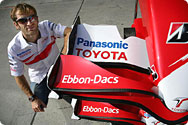 Despite working without rest after the end of the Japanese GP, the new front wing configuration wasn't quite ready for the Chinese GP. The team plans to introduce the new part at the Brazilian GP in two weeks.
Despite working without rest after the end of the Japanese GP, the new front wing configuration wasn't quite ready for the Chinese GP. The team plans to introduce the new part at the Brazilian GP in two weeks. The Chinese GP is held the week after the Fuji Speedway race, but we can’t halt our development work if we're to catch up to the top teams. Accordingly, we were busied ourselves preparing new aero parts to introduce at the Chinese GP, just one week following the Japanese GP. Despite our hard work, however, we still hadn't finished enough parts to equip both cars as the day for the race approached, so we weren’t able to bring the new parts to China. In basic terms, we came to China with our Fuji Speedway aero package, modified to match the downforce levels required by the Shanghai International Circuit. Since we weren’t able to demonstrate our full potential of the Fuji Special setup at the Fuji Speedway, we very much wanted to vindicate our work through our race performance at the Chinese GP.
Friday free practice progresses smoothly; both cars record top 10 lap times
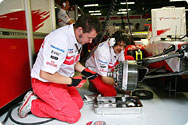 Major setup changes during Friday free practice paid off handsomely. While collecting valuable long–run data, both cars ran splendidly, finishing the day in the top 10 on the time charts.
Major setup changes during Friday free practice paid off handsomely. While collecting valuable long–run data, both cars ran splendidly, finishing the day in the top 10 on the time charts.At the end of free practice on the first day of race weekend, Jarno (Trulli) came in at P5 and Ralf (Schumacher) came in at P7 on the time sheets, which would have been quite sufficient for us to be happy. However, the only important position in motorsport is the position you find yourself as you cross the finish line on the final lap of the race. We can’t allow ourselves to get too excited about our position on the time charts during free practice sessions. We had a particularly difficult time with our setup on Friday, making some major changes to the car after the completion of Friday morning’s practice, including changing out the floor of the cars. But these changes had their desired effect, and we were able to complete our program in good order during the afternoon session. Not only were we able to dial in our settings, but we were also able to collect a lot of good data from our long runs. And having recorded some fairly impressive single–lap times, I tried to remind myself to simply enjoy our successes. Now, I just hoped we could carry this speed into Saturday and Sunday to avoid being labeled a "Friday Team."
Ralf changes settings; records best grid position this season at P6
I am terribly happy that Ralf was able to capture his best starting grid position this season since the Hungarian GP. While Ralf came in at P7 on the time charts during Friday's free practice, he wasn't completely happy with his car's setup, so we made some changes to the front and rear suspension settings, looking to improve mechanical grip. Our changes paid off, with Ralf setting the fifth–best lap during Saturday morning's free practice at 1m36.959s, and heading into afternoon qualifying in very good shape. While we didn’t experience any trouble during qualifying by any means, considering how we looked during the morning, and considering that we thought we'd improve slightly on our practice times in the qualifying session, coming in at 1m36.709s during Q2 (second qualifying session) was, in all honesty, a disappointment for us.
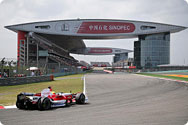 With some fine-tuning to improve mechanical grip, Ralf qualified at a season–best P6 grid position. Ralf suffered a rain-induced spin during the race.
With some fine-tuning to improve mechanical grip, Ralf qualified at a season–best P6 grid position. Ralf suffered a rain-induced spin during the race.When looking solely at our qualifying position, we probably could have saved another 0.2 or 0.3 seconds by taking off some downforce. However, we had been getting forecasts of rain for Sunday, which meant that taking off downforce wouldn't necessarily be a very smart decision. In the end, I think we made the best decision at the time. Meanwhile, Jarno was in fine condition during Friday, so we started Saturday morning’s free practice without making any tweaks at all. However, the track surface conditions changed as soon as the session started, significantly throwing off the balance of the car compared to the day before, and giving us a devil of a time. We tried a variety of different tactics, including changing out the center element of the front suspension and changing the torsion bar, but we couldn't find the right combination, and Jarno wasn't able to perform with the same sharp driving performance during qualifying.
With predictions for a wet race, and our ability to choose any fuel load we wanted, we looked forward to being able to move both cars up in position during the race.
Shooting for a reversal with tire selection; at the mercy of capricious weather
Starting off the grid at P6, Ralf received a slight tap from a car behind in the second corner, sending him into a spin. With no major damage to the car, Ralf immediately returned to the race, but the incident now left him at the very back of the pack with a long day ahead of him. Ralf kept his motivation, gaining positions with every lap, eventually rising as high as P12 before his first pit stop. Just at that time, several drivers who had changed from standard wet tires (shallow groove) to dry tires were recording faster times out on the course, so we switched to a one-stop strategy, equipping Ralf with dry weather tires, and sending him back out on the track. As luck would have it, rain started falling as soon as Ralf went back on the circuit, causing him to spin. The result was especially disappointing for us since we had Ralf’s car set up perfectly.
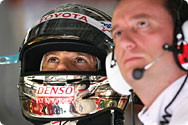 Jarno, starting from P12 on the grid, looked to finish in the points using a one-stop strategy. Unfortunately, the rain started falling even heavier after changing Jarno to dry weather tires, keeping him from increasing his race pace.
Jarno, starting from P12 on the grid, looked to finish in the points using a one-stop strategy. Unfortunately, the rain started falling even heavier after changing Jarno to dry weather tires, keeping him from increasing his race pace.Jarno, was able to skillfully avoid the confusion after the start, was originally settled for a one-stop strategy. On lap 24, Jarno moved as high as P9–almost in the points–driving a strong race in my opinion. With the track drying out, we brought Jarno in to the pits on lap 25, when dry tires were recording faster lap times. Jarno had enough fuel to stay out longer, but we switched Jarno from standard wet tires (shallow grooves) to dry weather tires, added enough fuel to last to the end of the race, and sent him back out.
Unfortunately, the rain started falling immediately after Jarno got out onto the track, making it difficult for Jarno to race on the dry weather tires. Several drivers came into the pits to switch back to wet weather tires, but we were convinced the rain wouldn't fall for long, and we decided to keep Jarno out. In the end, the rain stopped after a few laps, and while I think our judgment was correct, Jarno's pace on the half–wet track fell off more than we projected, costing him a number of positions. In the end, we weren't able to meet our goal of finishing in the points.Both the Japanese GP and Chinese GP ended with less-than-satisfactory results. One race remains in the 2007 F1 World Championship. For the Brazilian GP (the next and last race of the season), we are planning on introducing a new front wing configuration.
All of us at Panasonic Toyota Racing ask for your continued support–all the way to the finish!
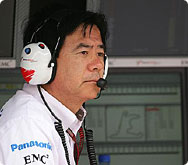
Noritoshi Arai at the Shanghai International Circuit. The second wet race in a row, the team was frustrated by not being able to show its true strength. Panasonic Toyota Racing will be throwing everything they have at the final race of the year-the Brazilian Grand Prix.